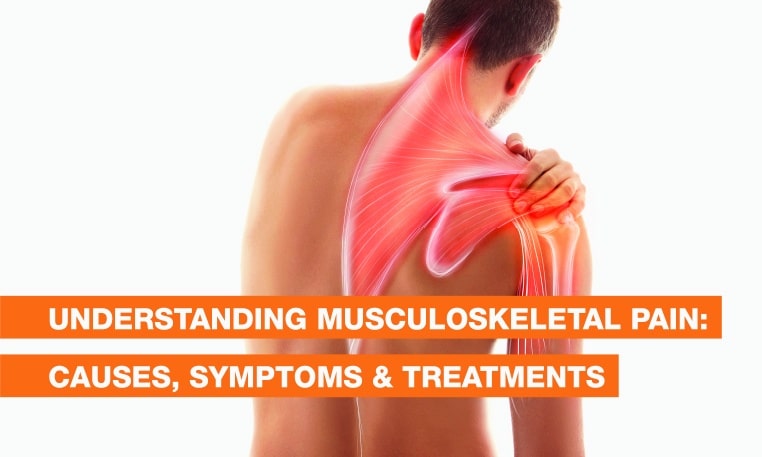Understanding Musculoskeletal Pain: Causes, Symptoms & Treatments
, 9 months ago
Musculoskeletal pain is a widespread condition affecting millions of people worldwide. Untreated pain can impact the work of daily life and the overall well-being of a person. In this blog, we will get a close insight into musculoskeletal pain, its causes, symptoms, treatment, and musculoskeletal pain meaning.
Musculoskeletal Meaning
Before learning about musculoskeletal pain, let’s get a clear idea of musculoskeletal meaning. The word Musculoskeletal itself is made of two words here: “musculo” stands for muscles, and “skeletal” stands for the bone system of the body; combining them refers to the system of the body, which comprises muscles, bones, joints, and tendons. The conditions related to them are referred to as musculoskeletal conditions.
What is Musculoskeletal Pain?
Musculoskeletal pain meaning discomfort or pain in muscles, bones, tendons, and ligaments. These kinds of pain can be acute (For short Periods) as well as chronic (for long periods) and can occur in various parts of the body. This condition may arise due to many problems, which we will discuss in the next section of this blog. We will cover “What is musculoskeletal pain?” and how it can significantly cause mobility problems that can be an issue in daily life routines.
Musculoskeletal Pain Cause
Musculoskeletal pain can arise due to many factors, some of which are listed below.
-
Injuries
The most common factor of Musculoskeletal pain is Injuries. Sports injuries such as strains, sprains, joint dislocations, and fractures are the major cause of this pain. They can be acute but last long (chronic) if not treated properly.
-
Arthritis
Inflammation of knee joints due to various factors such as ageing or injury is called Arthritis. If this condition persists for a longer period of time, then it can also lead to Musculoskeletal pain.
-
Poor posture
Not sitting or standing properly is a sign of poor posture and causes back spasms and strain, which are also reasons for this pain. This is more common to people who have a desk job.
-
Overuse
Overdoing any activities for a long period of time is one of the main causes of Musculoskeletal pain. Activities like typing or lifting weights repetitively can lead to overuse.
-
Medical Issues
Some medical conditions cause musculoskeletal pain. For example, fibromyalgia is an illness that features widespread pain, fatigue, and sensitivity in certain parts of the body. Other diseases that can lead to musculoskeletal discomfort include lupus and multiple sclerosis.
Symptoms of Musculoskeletal Pain
Symptoms of musculoskeletal pain usually vary depending on the cause of it. Some of the symptoms are as follows:
- Stiffness
- Aching or throbbing pain
- Swelling
- Limited mobility
- Fatigue
These are some of the most common symptoms listed above, but they can vary based on various factors. It is wise to always consult your doctor regarding your condition.
Musculoskeletal Pain Diagnosis
Diagnosis usually begins with a proper medical history and physical examination. The physician may ask about the onset, duration, and intensity of pain and any other symptoms. Diagnostic tests may include:
- X-rays: to detect bone structure or any kind of Arthritis.
- MRI or CT scan: To get a clear image of soft tissues like ligaments and tendons.
- Blood tests: To detect any underlying disease.
Musculoskeletal Pain Treatment
Although this pain is difficult to manage, proper treatment and prevention can help you reduce pain and make life easy.
- Medications :
Pain reliever medications like acetaminophen or nonsteroidal anti-inflammatory drugs (NSAIDs) can help reduce pain & inflammation. If pain is chronic, then your healthcare provider may suggest stronger medication.
- Physical Therapy :
Physical therapy can work as a game-changer for managing Musculoskeletal pain. A physical therapist can design an exercise tailored for you to strengthen muscles, enhance flexibility, and improve posture.
- Exercise :
Regular physical exercise can help you combat this problem. Low-impact activities like cycling, swimming, and walking can work wonders for you.
- Changing Lifestyle :
Some major alterations in lifestyle can make musculoskeletal pain management easier. Keeping a healthy weight reduces stress on joints, and if there are any changes at work that alter postures, then this reduces strain. Stress-reduction techniques such as yoga and meditation help address the psychological aspects of pain.
- Education and Support :
Understanding musculoskeletal pain and its management provides guidelines that any sufferer can easily follow. Information and support can be provided via educational materials and support groups so those with these conditions do not feel entirely alone in their battles.
- Additional Therapies :
Acupuncture, chiropractic care, and massage therapy are some of the additional therapies that you should consider while dealing with Musculoskeletal pain. People also claimed that they found more relief from these alternative therapies.
Conclusion
Musculoskeletal Pain is one of the most complicated conditions responsible for patient pain and distress of any age group. The study of aetiology, symptom identification, and management modalities is considered to be the key elements in treating this prevalent problem. These can include the use of medication, physiotherapy, lifestyle adjustment, or alternative therapy and could become useful treatment techniques for achieving pain relief and quality of life. If you or someone you know is suffering from this pain, the first step to finding relief and reclaiming a more active and fulfilling life may come from seeking guidance from healthcare professionals.

